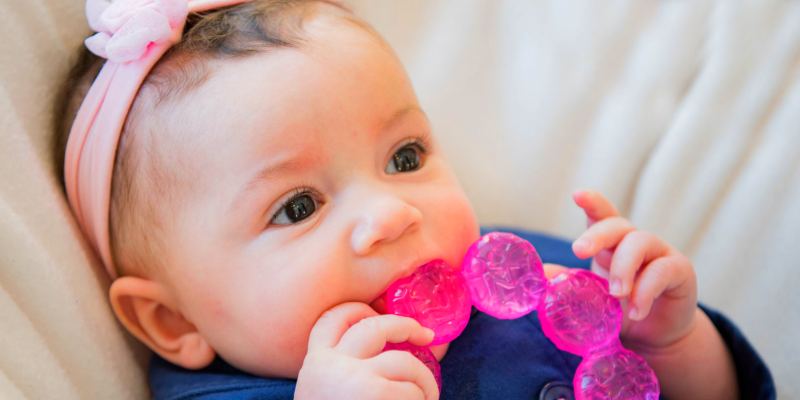What are the best ways to identify teething pain signs in babies? Our guide outlines the top clues and how to relieve teething pain naturally.
Find more parenting guides, tips and advice
You wonder how you can tell that your baby is about to have its first teeth? We’ll tell you. Lately extensively, your baby drools a lot more and is somehow constantly in a bad mood? It may be because the first tooth is about to erupt.
Whining, loss of appetite and poor sleep: teething can sometimes be really painful for the little ones. So we have put together a few tips to identify teething pain signs and avoid teething pain in babies.
The milk teeth
When the first tooth in a infant arrives is very individual. Most infants show their first tooth between the fourth and sixth months. In rare cases, some babies are born with their first teeth. For others, the first tooth appears only on their first birthday. Just be patient and don’t worry too much if your baby’s mouth doesn’t show any teeth after the first six months.
The so-called seeds of the milk teeth are already deposited in the jaw in the womb. A child’s deciduous dentition then consists of 20 teeth, including eight incisors, four canines and eight molars. By the way, the last molars are often the last to break through. Most of the time, the milk teeth are not complete until the age of two.
The baby teeth remain with the little ones until they reach school age. Then they grin proudly and present their tooth gaps. But there is still some time until then. First of all, the first tooth has to show itself.
Teething development order
The child’s dentition or development order consists of 20 teeth, including eight incisors, four canines and eight molars. Teething can take a long time: the last four molars often break through with a time lag. Most children don’t have full teeth until they are two years old.
The order of teething varies from child to child. For most children, teeth come in the following order:
- lower central incisors
- upper central incisors
- lower external incisors
- upper external incisors
- upper and lower anterior molars
- upper and lower canines
- upper and lower posterior molars
First clues to identify teething pain signs
- The child is drooling more and more.
- One cheek is flushed and warm without your baby having a fever.
- The child likes to put objects or his fist in their mouth and chew on them.
- They have a sore bottom and thin stools or diarrhea or constipation.
- The gums are reddened in one place, maybe a tooth is already shining through.
During the period in which the first tooth is slowly being pushed through the gums, very typical symptoms often occur to help you identify teething pain signs. Some experts state that symptoms such as moodiness, diarrhea and fever in particular are not directly related to teething.
They attribute these symptoms to the fact that children put all sorts of things in their mouths during this time to massage their gums by chewing. They are increasingly using viruses and other germs in contact.
While some babies have no problems during teething apparently, it is sometimes quite painful for others and anything but easy. Reddened cheeks and swollen gums are clear signs of teething. If you add any of the following signs, now is the right time to give your child some relief:
1. The baby chews and gnaws on everything that is tangible, including its own fist if necessary.
2. The drool cloth is used much more often because more saliva is produced during teething.
3. The increased drooling makes the skin around the mouth sore, like a rash.
4. The mood was seldom worse.
5. Your baby has a lot less appetite than usual.
6. Sleep is rather restless and poor overall.
7. Whining, screaming and crying – these are also more common now.
Teething problems in babies
The pressure on the roof of the mouth, the swelling of the mucous membrane, and the breakthrough through the gums are painful for many babies and young children. ” Before the teeth erupt, the gum can be reddened and swollen. The tooth presses and tightens the gums ,” explains Dr. Wolfram Hartmann, President of the Professional Association of Pediatricians . No wonder they whine now and need more affection.The pressure on the roof of the mouth, the swelling of the mucous membrane and the painful breakthrough through the gums are common to many infants as well toddlers.
Fever and diarrhea are not directly triggered by teething, even if the rumor persists. However, experience shows that many teething babies and toddlers have a fever and diarrhea at the same time. This can be explained by the fact that they put everything in their mouths, which means that infections are more common. At the same time, the body is weakened by teething and the immune system is more vulnerable.
How long does teething pain last? Every toddler processes teething differently: While the teeth creep in in some children without being noticed, others suffer weeks before something can be seen in the oral cavity.
Teething pain relief
- Many children like to chew on a cool damp washcloth. Our tip: If you soak it in cool chamomile tea beforehand, it has a calming and pain-relieving effect at the same time.
- You can also give the child lukewarm chamomile blossom or sage leaf tea to drink; this will reduce inflammation.
- A drop of chamomile in a tablespoon of good rapeseed oil can be used as a teething oil and massaged on the gums regularly.
- Teethers chilled in the refrigerator or vegetables such as carrots also help with teething.
Homeopathy and salts
Often homeopathic remedies are recommended when babies are having trouble teething. Everyone has a different opinion, but there is no scientific evidence. It’s best to get advice from experts.
The following salts are said to help with teething:
- Calcium phosphoricum D6 is supposed to help build up the tooth mass and alleviate discomfort when it breaks through.
- Calcium fluoratum D12 is said to help with delayed teething by improving the elasticity of the tissue and thus making it easier for the tooth to pierce.
The easiest way to give infants under one year of age is homeopathic globules with a spoon of water or tea; older children can let them dissolve directly in their mouths. Please get advice from the pediatrician beforehand! The globules Belladonna, Chamomilla and Osanit are used for teething children. Another homeopathic remedy that can help with anxiety and fever are Viburcol suppositories.
Some parents swear by amber necklaces. Supposedly they are supposed to relieve the pain and the child has something to chew on. However, the effectiveness of amber necklaces has not been proven. On the contrary: it is dangerous to put chains or bracelets on small children. They can get caught and get stuck somewhere or they choke on loose parts.
What relieves teething pain?
Most children are now looking for closeness, want to cuddle more and need loving attention. Try to distract your child a little. Taking a walk or simply fooling around can alleviate the symptoms.
If that’s not enough, you can offer your child a chilled teething ring or a wet washcloth. A gentle massage of the gums with a soothing teething gel from the pharmacy can work wonders.
Help from the pharmacy
If the gentle remedies are not enough, seek advice from the pediatrician and, if necessary, get a remedy from the pharmacy.




